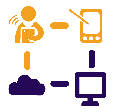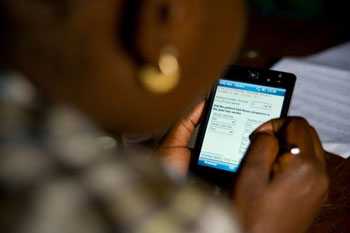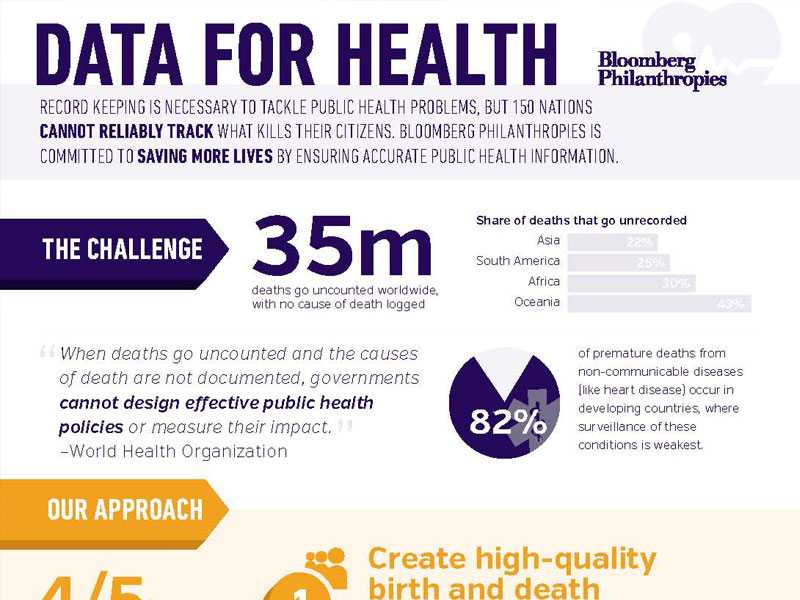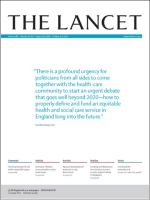Data for Health Initiative
New training module
Training Course on Civil Registration and Vital Statistics (CRVS) Systems
Designed for public health professionals, this course provides information about characteristics, functions, uses, assessment, and improvement of CRVS systems.
New publication
"Understanding death, extending life"
The newest article in a series published in The Lancet on the importance of Civil Registration and Vital Statistics. Co-authored by Mike Bloomberg and Julie Bishop.
CDC is collaborating with Bloomberg Philanthropies, CDC Foundation, and other partners to work toward strengthening public health systems in low- to middle-income countries across Latin America, Asia, and Africa.
The Bloomberg Data for Health initiative strengthens the collection and use of critical public health information. The Initiative will collaborate with up to 20 interested low- and middle-income city and country governments to:
- Strengthen the quality of birth and death registration, including causes of death
- Explore innovative approaches to non-communicable disease surveys and surveillance
- Enhance use of data for maximum impact in policymaking and priority setting
Data for Health approaches its goal in 3 ways as a roadmap to improving global health: systems, innovation, and communication. There is an emphasis on using data to identify opportunities, ensure accountability, and maximize the impact of limited resources. When combined, this will improve capacity in Ministries of Health to use health data to inform public health policy development and help 1.2 billion people across the globe live healthier, longer lives.
Systems: Civil Registration and Vital Statistics (CRVS) Improvement

The challenge: Lack of usable data and data collection systems.
Civil Registration and Vital Statistics (CRVS) information systems collect information on number of births and deaths, as well as cause of death. According to the World Health Organization (WHO), many countries do not have adequate systems in place to collect this data, resulting in millions of births and more than 38 million deaths going unreported each year.[i]
What this means: Health professionals and governments use data in deciding how to address the needs of communities. Information on births is needed to determine how many people are in need of resources. Cause of death information helps public health experts decide which programs can save the most lives. Without accurate data, it is difficult to know what solutions could help communities.
How the initiative will help: The Initiative will support countries in strengthening their CRVS systems. Assistance will be available to assess CRVS systems and develop improvement plans, improve cause of death assignment using internationally recognized standards, improve registration practices, and produce high quality data.
CDC contribution: CDC’s National Center for Health Statistics will provide technical expertise and help develop a workable system to capture accurate information on births and deaths. With its partners, CDC hopes to improve health data registration systems, which will improve the quantity and quality of this data to inform policy-making.
Innovation: Noncommunicable Disease Risk Factor Surveillance

The challenge: Finding alternative methods to collect data.
In many countries, health workers collect health data using in-person surveys. While this is a useful way to collect some data, it can be time consuming and costly. Decreasing the time it takes to collect, analyze, and communicate data can help improve the allocation of resources and decrease preventable deaths, especially in areas most in need of healthcare services.[ii]
What this means: Efficient monitoring and surveillance are cornerstones to track progress. Systematic monitoring of risk factors and vital records is essential. With accurate data and analysis, countries will be able to prioritize essential resources and make sound policy decisions.
How the initiative will help: With increasing use of mobile phone access globally, opportunities exist to explore the feasibility of using this technology as an interim method to collect data and complement household surveys. Such technologies have the potential to allow for efficiencies in producing timely, affordable, and accurate data to monitor trends, and supplement traditional health surveys with new, faster mobile phone surveys.
CDC contribution: CDC’s Global Noncommunicable Disease Program will work throughout the agency and alongside partners to implement mobile phone surveys in ten countries and test whether using mobile phones to collect health data is useful. The project will assess the feasibility, quality, and validity of using mobile phone surveys to determine whether it can meet the standards of face-to-face collection methodology.
Communication: Strategic Use of Data for Policy and Planning

The challenge: Not enough data is being turned into action.
Many low- and middle-income countries struggle to use public health data to inform policy decisions. This is partially because of a shortage of epidemiologists with specialized health policy writing and communication skills, and lack of a forum in which to share scientific findings.
What this means: Policy makers do not have the public health information needed to make decisions based on the needs of communities. Community health needs continue to be unmet, and preventable deaths continue.
How the initiative will help: The Initiative will collaborate with governments on using data to prioritize health issues, develop policies and programs, monitor impact, and communicate with stakeholders. Technical assistance will be available to help develop the skills needed to analyze data from a policy perspective; use information technology to compile, manage, and share data from multiple sources; and present and disseminate data to stakeholders. The partnership will provide training in epidemiology, scientific writing, and communication and will develop data-use committees and public health publications.
CDC contribution: CDC will develop a curriculum to be shared through Field Epidemiology Training Program (FETP) residents, who will provide specialized in-country training using epidemiology case studies and other effective learning modules. FETP residents will assist in developing communication tools to help inform policy. Our National Public Health Institutes program will aid in strengthening countries' data communication platforms, which are used to share public health information with policymakers and the public.
The Partnership
The partnership, funded by a grant from Bloomberg Philanthropies, will improve capacity in Ministries of Health to use health data to inform public health policy development.
Current partners include:
Announcements and Press Releases
Key Scientific Articles and Reports
Public Health Bulletins
Series: Counting Births and Deaths 2015
The Counting Births and Deaths Series
This Lancet series, which reviews progress since the seminal 2007 “Who Counts?” series, describes the growing momentum for civil registration and vital statistics (CRVS) systems in countries and in the global health and development community more broadly, stimulated by the need to monitor progress and accountability for the Sustainable Development Goals post-2015 era.
October 2015
- A global assessment of civil registration and vital statistics systems: monitoring data quality and progress, Lancet. 2015 Oct 3; 386 (10001): 1395 - 1406.
- Alan Lopez: making everyone count, Lancet. 2015 Oct 3; 386 (10001): 1331.
- Are well functioning civil registration and vital statistics systems associated with better health outcomes?, Lancet. 2015 Oct 3; 386 (10001): 1386 - 1394.
- Civil registration as a means to promote human security, Lancet. 2015 Oct 3; 386 (10001): e14 – e15.
- Towards universal civil registration and vital statistics systems: the time is now, Lancet. 2015 Oct 3; 386 (10001): 1407 – 1418.
- Understanding death, extending life, Lancet. 2015 Oct 2; 386 (1312)
May 2015
- Civil registration and vital statistics: progress in the data revolution for counting and accountability, Lancet. 2015 May 10; 386 (10001): 1373 - 1385.
- Everyone counts- so count everyone, Lancet. 2015 May 10; 386 (10001): 1313 - 1314.
- Page last reviewed: May 10, 2017
- Page last updated: May 10, 2017
- Content source:


 ShareCompartir
ShareCompartir




